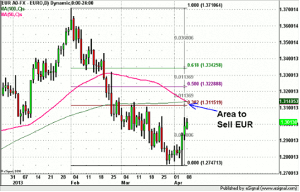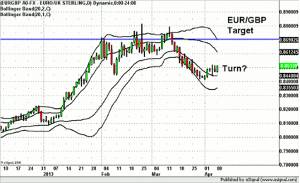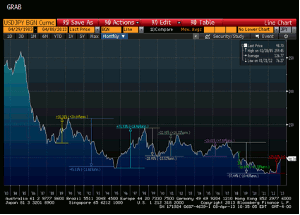There are three attractive trading opportunities that we see in the second quarter, writes Kathy Lien of BKForex.com.
The second quarter of 2013 started with the bang. Key fundamental shifts in monetary policy and underlying changes in various economies caused a significant increase in volatility across the foreign exchange market. The sell-off in the Japanese yen caused by the Bank of Japan drove all of the major currencies higher. Since last Thursday, every major currency including the US dollar, euro, and British pound appreciated between 5.5% to 7.5% against the Japanese yen. While shorting yen is one of the most attractive trading opportunities for the second quarter, it is not the only one.
So even though selling yen is our favorite trade of Q2, we start with less popular ones.
Trade #1 – Tactical Positioning in the US Dollar
The first quarter of 2013 was marked by consistent improvements in the US economy that drove the dollar, US yields, and equities higher. Friday’s abysmal non-farm payrolls report sent shock waves across the financial markets and we believe that this will be the first of many disappointments in the US economy in the second quarter. While this week’s Fed minutes are optimistic, it will be important to remember that policymakers did not have the latest payrolls report on hand before the March meeting. Therefore traders should take any talk of tapering asset purchases with a grain of salt because the views of many Fed officials probably changed as a result. Normally we would say that selling USD/JPY would be the best way to position for lower US yields but the impact of Bank of Japan easing supersedes mixed US data (See Trade #3 for more on the yen). USD/JPY took out new highs even as 10-year Treasury yields plunged from a high of 2.05% to its current level of 1.7%.
Sell the Dollar Against these Currencies - We don’t expect risk on/risk off to be a major driver of the dollar in the second quarter. Instead the trade will require tactical positioning in the US dollar because it will be all about relative performance. We expect slower US growth to drive the dollar lower against higher carry currencies such as the Australian and New Zealand dollars. USD/CAD could also fall as more recent indicators point to a stronger recovery in the second quarter. While Canada reported net job losses, manufacturing activity grew at its fastest pace in seven months, which should filter down to the economy. With this in mind, selling the USD against the AUD, NZD, and CAD at current levels is not a good idea because these pairs have already run up—we prefer instead to wait for a 1% retrace.
NEXT PAGE: Reload GBP Shorts
|pagebreak|Buy the Dollar Against these Currencies - There are also currencies that we want to buy the dollar against, namely the GBP (see trade #2), the JPY (see trade #3), EUR and KRW (Korean won). Our views on the dollar against the GBP and JPY are detailed below so we’ll spend our time talking about the EUR and KRW. Once again, we do not believe that the EUR/USD should be sold at current levels because we expect the rally to extend in the near term. However, if the EUR/USD rises to 1.3135 to 1.32, this would be an ideal level to sell. The primary reason for the EUR’s breakout last week was the ECB failed to lay the foundation for a rate cut and suggested their toolbox is empty. These are hardly the words of an optimistic central bank particularly since Mario Draghi also stressed the downside risks to their outlook. A rate cut is still on the table and without a single supervisory mechanism, other countries could fall victim to the same problems as Cyprus. In addition, we expect growth to remain weak as austerity measures limit economic activity in the region.
Our view on the Korean won carries over to our view of many other Asian currencies. The Japanese yen has weakened significantly and is likely to get even weaker, which poses a significant threat to countries that compete and export to Japan like Korea. Japan is a leading competitor of South Korea in the market for high-tech manufactured goods and the strength of the weakness of the yen, plus the strength of the won, hurts the attractiveness of Korean goods, which translates into weaker economic activity and a weaker currency.
Trade #2 – Reload GBP Shorts as Carney Takes Office in June
At the beginning of the first quarter, we said one of our favorite FX trades was to sell the British pound, against the EUR. While EUR/GBP ran from a low of 81 cents to a high of 88 cents during Q1, it has since fallen far off its lows and is currently trading at 85 cents. We believe that it is time to reload GBP shorts, against the EUR and the USD. While our preference is to buy EUR/GBP, the GBP/USD also reached a key resistance at 1.54 and could struggle here.
For most of the first quarter, sterling had been in a very strong downtrend but the currency bottomed in the beginning of March after the Bank of England minutes revealed renewed concern about inflation. Prior to that, investors had widely believed that the BoE would ease again but the focus on price pressures and the impact of a falling currency shut the door on this possibility. However, we believe that this reluctance to ease is only temporary. BoE Governor King is stepping down at the end of June and barring any major financial crisis, a chance of significant changes in monetary policy is slim. However, the game changes completely when Mark Carney takes office with a mandate to transform monetary policy. While he doesn’t join the BoE until June, expectations on his level of aggressiveness can start to affect sterling as early as May.
NEXT PAGE: Targets in USD/JPY
|pagebreak|UK economic data has been mixed with improvements at the beginning of March starting to fade. The central bank’s focus on inflation is very “data dependent” and could change if fiscal consolidation or slower global growth starts to weigh on the economy again. Aside from the BoE’s concerns about inflation, sterling also rallied at the end of the first quarter because the problems in Cyprus drove European investors back into the safety of the GBP. If contagion from Cyprus is limited, and the euro starts to recover from here, then the quasi-safe haven status of GBP becomes less attractive to regional investors.
The following chart of EUR/GBP shows the currency pair stabilizing at 85 cents—we are looking for a move back up to 87 and possibly even 88 cents.
Trade #3 – Targets in USD/JPY
USD/JPY was on a tear last week thanks to bold and aggressive easing from the Bank of Japan and the last time we saw a move this large was in November 2011 when the BoJ intervened in its currency. When it comes to USD/JPY, it is important to realize that trends in the pair can last for a very long time and extend further than what most would imagine.
Between 2007 and 2011, the currency pair dropped nearly 40%. There were certainly recoveries along the way but they were brief and shallow. Before that, between 2005 and 2007, USD/JPY rose 20% and a similar move was seen between 2002 and 2005. Over the past year, USD/JPY has already appreciated nearly 28%, leading many investors to wonder how high it can rise. Considering that the Bank of Japan has just begun easing, there’s a lot more room to the upside. Its 10-year average is 100 and at minimum a full 30% move from the low would take USD/JPY to 103. We therefore expect USD/JPY to rise to 100 and 103 with an extension to 105 also possible but 110 may be a stretch.
What the Bank of Japan has done is officially eliminate any reason to buy yen over the next two years. Their commitment to bold easing means they will do everything in their power to drive down yields, leading to a more aggressive shift out of Japanese bonds by domestic investors. They will look abroad for higher yields and they will do it on an unhedged basis as the BoJ’s policies should lead to further weakness in the Japanese yen. In other words, the central bank has effectively given Japanese investors a reason to go global. Their “Quantitative and Qualitative” easing is the central bank’s boldest monetary policy program in recent history, and as we have seen in the reaction to the US non-farm payrolls report, it supersedes the ebbs and tides of the US economy.
In the long run, the Nikkei should also benefit from Japan’s policies and as shown in the chart above, USD/JPY has a very strong positive correlation with the index so a further rise in Japanese stocks should help fuel the rally in USD/JPY.
By Kathy Lien, Co-Founder, BKForex.com
























